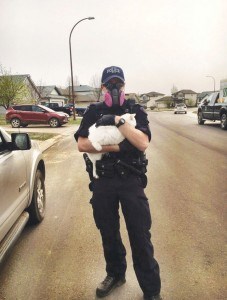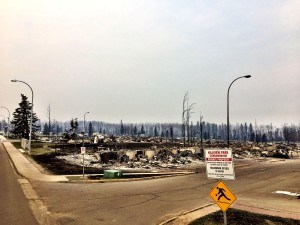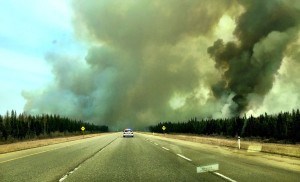
As tens of thousands of people fled the wildfire threatening to overrun Fort McMurray, May 3, there were a handful of others who were charging straight into the burning inferno.
One of those people was Jasper’s RCMP Const. Patrick Vallee.
By coincidence, Vallee was in Wainwright, Alta., training with the RCMP’s Special Tactical Operations unit when they caught wind about the catastrophic wildfire approaching the northern Alberta community.
In response, 40 officers were immediately flown to Fort McMurray to help bolster the local police force, but it quickly became clear they would need more help and equipment to safely evacuate the community. Later that evening another 40 officers were deployed, including Vallee, who was instructed to drive to Edmonton to pick up equipment before continuing to Fort McMurray.
“We packed up the trucks with everything, like food, clothes, ammunition, firearms because we didn’t know what to expect or how long we would be there,” said Vallee.
By the time Vallee arrived, on May 4, the mandatory evacuation order was already in effect and by 10:30 a.m. that morning 1,600 structures were said to be destroyed.
In most situations the RCMP would have gone straight to the local police detachment for further instructions, but it had already been evacuated so they went to a temporary command post set up at an oil rig camp not far from town.
Divided into teams of four, Vallee’s first task was to go door-to-door to ensure everyone had evacuated.
In some cases, they found pets that had been left behind by their owners and contacted the SPCA and members from the RCMP’s special entry unit from Edmonton to get the pets out safely.

While the vast majority of people heeded officials’ advice to evacuate the city, some people stayed put, refusing to leave.
“We didn’t remove anybody with force,” said Vallee. “If people told us they weren’t leaving, as long as there were no children in the house and as long as everybody who was there was able to make a clear and conscious decision that they still wanted to be there, we didn’t have time to start fighting with people.”
Although he personally didn’t run into anyone who refused to leave, he said some of his colleagues did.
“We just advised them of the risk that the fire was coming and would be at their door pretty soon and told them that once the fire was there if you call 911 we’ll do our best to come get you, but we don’t know if we will be able to help at that point,” said Vallee.
He said there were several instances where people who stayed behind had to be rescued by firefighters after calling 911, diverting resources from the front lines and putting first responders at risk.
Like many of the first responders who were in Fort McMurray at the height of the blaze, Vallee said he worked 22 hours straight during his first shift.
“It was a long day. All the guys were exhausted because some of them had worked all night long,” said Vallee. “I got lucky because I was able to get maybe two or three hours sleep the night before and then drove all the way up to Fort McMurray.”

“During my first shift I remember there was this one point we had a short break so I had a nap on the grass for a half an hour. Some guys were sleeping on the pavement or against the building.”
After a long and trying shift, Valle and his team headed to an oil rig camp near Anzac, southeast of Fort McMurray to get some rest, only to be woken again around 2 a.m. and told to evacuate.
Unable to drive north to Fort McMurray because of the fire, Vallee was among a convoy of 50 vehicles forced to go south towards Lac La Biche on Highway 881, before going north again on Highway 63 toward Fort McMurray, essentially turning a 40 minute drive into a five hour drive.
Once they arrived, they set up camp at a lodge north of Fort McMurray only to be evacuated the following day.
“It was just evacuation after evacuation,” said Vallee. “It was hard to plan how fast the fire was moving and some places the smoke was so bad we couldn’t stay there.”
To make matters worse, Valle and 10 other officers caught the Norwalk virus part way through their deployment and had to be quarantined for 48 hours.
“The second day I was sick the doctor told me it was up to 60 people, including firefighters,” said Vallee, who was hooked up to an IV for the first 24 hours.
By May 10–a full-week after being deployed–he was discharged with a clean bill of health and released along with the rest of the Special Operations Tactical unit, who were replaced by a similar unit from British Columbia.
Reflecting on the whole ordeal, Valle said he learned a lot from his experience.
“It was a tough deployment, but I’m just glad I was able to help out.”
Paul Clarke
[email protected]
